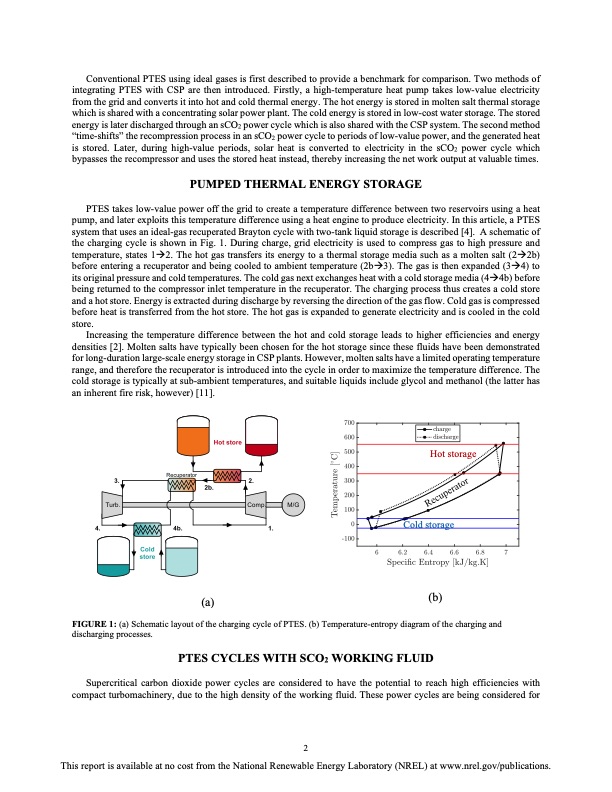
PDF Publication Title:
Text from PDF Page: 005
Conventional PTES using ideal gases is first described to provide a benchmark for comparison. Two methods of integrating PTES with CSP are then introduced. Firstly, a high-temperature heat pump takes low-value electricity from the grid and converts it into hot and cold thermal energy. The hot energy is stored in molten salt thermal storage which is shared with a concentrating solar power plant. The cold energy is stored in low-cost water storage. The stored energy is later discharged through an sCO2 power cycle which is also shared with the CSP system. The second method “time-shifts” the recompression process in an sCO2 power cycle to periods of low-value power, and the generated heat is stored. Later, during high-value periods, solar heat is converted to electricity in the sCO2 power cycle which bypasses the recompressor and uses the stored heat instead, thereby increasing the net work output at valuable times. PUMPED THERMAL ENERGY STORAGE PTES takes low-value power off the grid to create a temperature difference between two reservoirs using a heat pump, and later exploits this temperature difference using a heat engine to produce electricity. In this article, a PTES system that uses an ideal-gas recuperated Brayton cycle with two-tank liquid storage is described [4]. A schematic of the charging cycle is shown in Fig. 1. During charge, grid electricity is used to compress gas to high pressure and temperature, states 12. The hot gas transfers its energy to a thermal storage media such as a molten salt (22b) before entering a recuperator and being cooled to ambient temperature (2b3). The gas is then expanded (34) to its original pressure and cold temperatures. The cold gas next exchanges heat with a cold storage media (44b) before being returned to the compressor inlet temperature in the recuperator. The charging process thus creates a cold store and a hot store. Energy is extracted during discharge by reversing the direction of the gas flow. Cold gas is compressed before heat is transferred from the hot store. The hot gas is expanded to generate electricity and is cooled in the cold store. Increasing the temperature difference between the hot and cold storage leads to higher efficiencies and energy densities [2]. Molten salts have typically been chosen for the hot storage since these fluids have been demonstrated for long-duration large-scale energy storage in CSP plants. However, molten salts have a limited operating temperature range, and therefore the recuperator is introduced into the cycle in order to maximize the temperature difference. The cold storage is typically at sub-ambient temperatures, and suitable liquids include glycol and methanol (the latter has an inherent fire risk, however) [11]. Hot storage Cold storage (a) (b) FIGURE 1: (a) Schematic layout of the charging cycle of PTES. (b) Temperature-entropy diagram of the charging and discharging processes. PTES CYCLES WITH SCO2 WORKING FLUID Supercritical carbon dioxide power cycles are considered to have the potential to reach high efficiencies with compact turbomachinery, due to the high density of the working fluid. These power cycles are being considered for 2 This report is available at no cost from the National Renewable Energy Laboratory (NREL) at www.nrel.gov/publications.PDF Image | Supercritical CO2 Heat Pumps Concentrating Solar Power

PDF Search Title:
Supercritical CO2 Heat Pumps Concentrating Solar PowerOriginal File Name Searched:
77955.pdfDIY PDF Search: Google It | Yahoo | Bing
CO2 Organic Rankine Cycle Experimenter Platform The supercritical CO2 phase change system is both a heat pump and organic rankine cycle which can be used for those purposes and as a supercritical extractor for advanced subcritical and supercritical extraction technology. Uses include producing nanoparticles, precious metal CO2 extraction, lithium battery recycling, and other applications... More Info
Heat Pumps CO2 ORC Heat Pump System Platform More Info
| CONTACT TEL: 608-238-6001 Email: greg@infinityturbine.com | RSS | AMP |